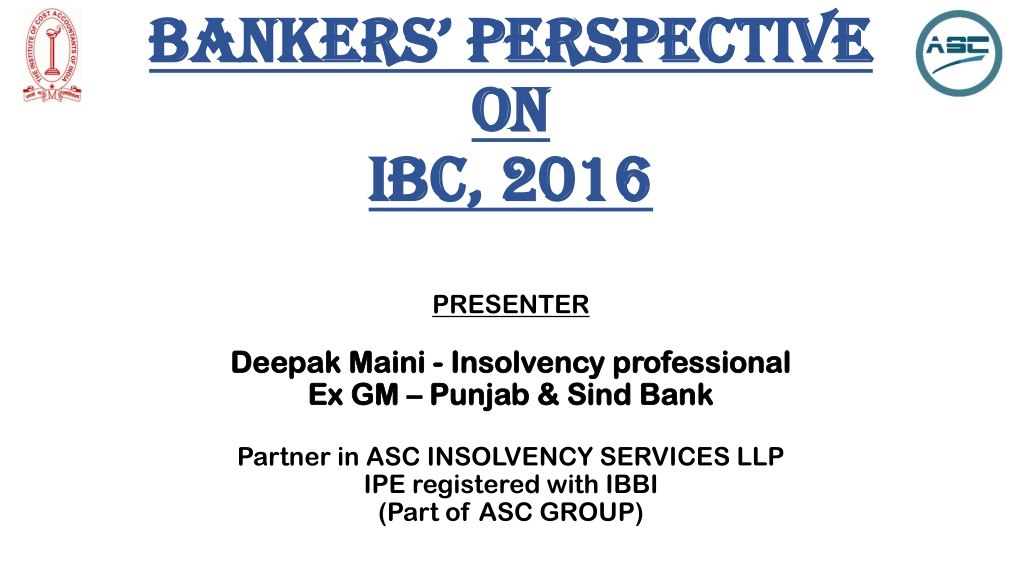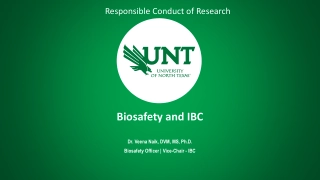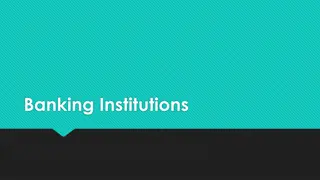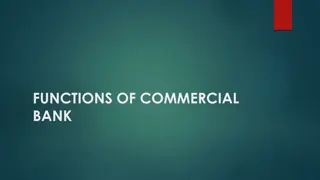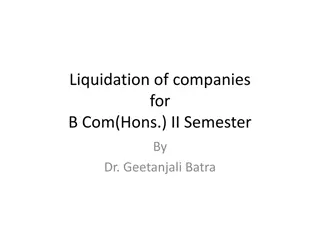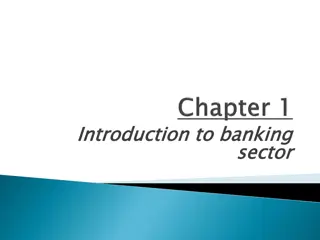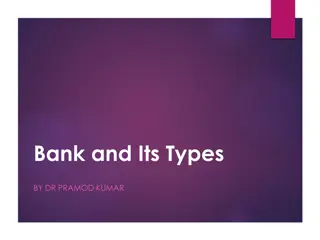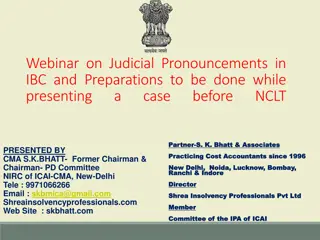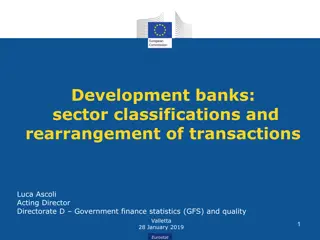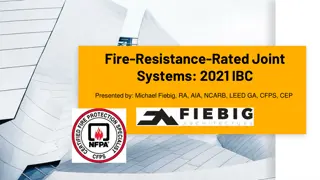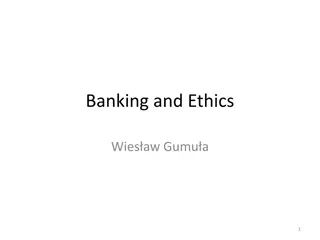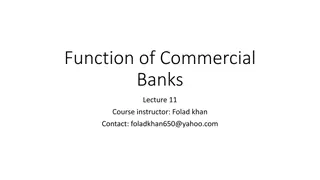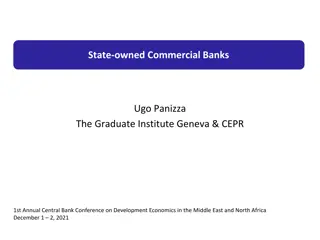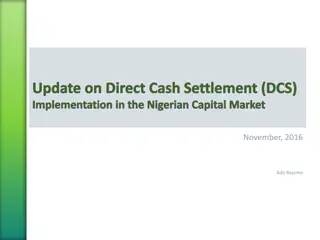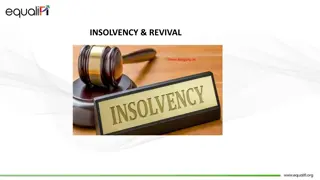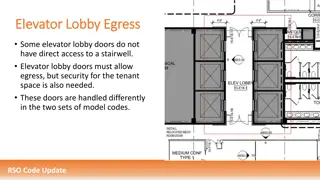Challenges Faced by Banks in Adopting IBC
Banks face challenges in adopting the Insolvency and Bankruptcy Code (IBC) due to stringent provisioning norms, additional costs, and complexities in referring cases to the National Company Law Tribunal (NCLT). Secured NPA accounts older than 2 years, unsecured NPA accounts in the second year, and cases involving corporate loans with fraudulent activities are recommended for NCLT referral. Banks cannot avoid IBC entirely as other creditors can initiate Corporate Insolvency Resolution Process (CIRP) under NCLT. Urban branches struggle with identifying insolvent corporate accounts despite guidelines from the Head Office.
Download Presentation

Please find below an Image/Link to download the presentation.
The content on the website is provided AS IS for your information and personal use only. It may not be sold, licensed, or shared on other websites without obtaining consent from the author. Download presentation by click this link. If you encounter any issues during the download, it is possible that the publisher has removed the file from their server.
E N D
Presentation Transcript
Bankers PersPective Bankers PersPective ON ON IBC, 2016 IBC, 2016 PRESENTER Deepak Deepak Maini Ex GM Ex GM Punjab & Sind Bank Punjab & Sind Bank Maini - - Insolvency professional Insolvency professional Partner in ASC INSOLVENCY SERVICES LLP IPE registered with IBBI (Part of ASC GROUP)
Why Banks are hesitant to adopt IBC? RBI guidelines that all cases referred for CIRP shall have 50% provisioning. Cases ordered for liquidation under CIRP should have 100% provisions. Existing provisioning norms of Banks:
Banks will have challenges in referring secured NPA accounts upto 3 years (1 year substandard + 2 years doubtful) old cases to NCLT because it will call for additional provisioning. Banks are already facing higher % of stressed assets & incurring losses due to provisioning though they are in operational profit. Recovery actions in most of NPA cases already initiated under DRT or SARFAESI Act & incurred legal expenses. Now, after initiating action under DRT/SARFAESI, to file under NCLT/IBC, second round of cost to be incurred by them.
What type of cases Banks can identify for referring to NCLT ? Secured or partly secured NPA cases which have crossed 2 years or where provisioning are already more than 50%. Unsecured NPA accounts entering into second year. Corporate Loans where Consortium Lending or Multiple Financing is done. & Secured by way of change on company s assets. Corporate loans where preferential, extortional, fraudulent transactions and diversion of funds is observed should be referred to NCLT. Corporate Loans which are backed promoters/directors/guarantors can be recovered under DRT or SARFAESI Act & may not be referred to NCLT. by strong collaterals of
Can Banks avoid IBC & not refer cases to NCLT If there is default the operational creditor or the corporate debtor itself can approach NCLT for CIRP Recently, class of creditors have been added Allottees ( Home Buyers & Commercial Space) as Financial Creditors, they can move NCLT. In such cases the Banks or Financial Creditors have to file their claims even though CIRP has not been initiated by them. They have to act as COC as per the IBC and participate in CIRP. Thus, Banks can t take an infinite stand not to refer the cases to NCLT.
Challenges in adoption of IBC at Bank Zonal/Regional offices and Branches in particular Corporate loans accounts showing signs are insolvency Urban branches of Banks would mostly have Corporate Accounts showing insolvent tendencies. Though guidelines have been issued by Head Offices- for branches to follow, but branch staff specially public sector is over occupied to read & note them. Large corporate branches do have NCLT desks, but staff of other major branches have to handle it along with other tasks. Frequent interactions, seminars or one day training modules of NCLT should be held, and staff should be made aware of IBC provisions & Bank s guidelines.
Major Involvement of Bankers in matters & Decision Making during CIRP Appointment of IRP & RP - Calling EOI (Technical & Financial Bids) - Technical Qualifications- How many cases handled as CIRP? - How many resolution plans achieved? - How many went for Liquidation? -Whether backed by Insolvency Professional Entity? - IT Infrastructure & Board rooms, VC faculty - Who are in the core team of IRP/IP? - Domain Experts available - Consultants available - Financial Bid- IRP Period- Professional Fees of IRP for IRP period - Industry Expert required to be engaged costs - Manager required to run day to day operations - Chartered Accountants required for accounting purposes - IT experts during IRP - RP Period- CoC deliberates the requirement, negotiates the fess, fixes it.
Interim Finance (IF) Required to run to concern - if cash flows are not sufficient Best situation is if secured FCs themselves come up & offer IF at reasonable terms. This will avoid time consumed in creation & registration of charge, will avoid days. Otherwise, any outsider ready to finance may ask for Charge registration. Information Information Memorandum Memorandum To do in-depth examination of IM to understand size & scale of insolvency There may be new found facts which were not in the knowledge of Bankers through they had given finance to the Corporate Debtor.
Finalizing Eligibility of Prospective Resolution Finalizing Eligibility of Prospective Resolution Applicants (PRAs) under Expression of Interest Applicants (PRAs) under Expression of Interest What should be eligibility criteria fixed for PRA? Their Net worth, experience, cash or cash equivalent availability Whether consortium of PRAs to be permitted as PRAs, if yes what will be eligibility criteria for them Evaluation Matrix Evaluation Matrix It s a matrix through which various RPs are compared & evaluated. Quantitative Parameters - Upfront Cash recovery, NPV of Continuing Portion of Debt, Term of continuing portion of debt, - Interest rate offered, Equity upside/right of recompense/position additives of existing lenders - Fresh Equity infusion and its time period, How interest of all stake holders addressed Qualitative Parameters - Experience of Resolution Applicant, Promoter group track record in honoring debt commitments & in turning around distressed entities - Record of regulatory compliances, financial strength for the RA and group - External Credit Rating (of flagship company), RA s group specialization in any industry segment - Availability of additional collateral security and personal/ corporate guarantee & value thereof What should be mix of such parameters, weightage between Quantitative or Qualitative (say 70:30 or 80:30)
Examination of feasibility & Viability {section: 30(4)} Primary responsibility cast upon COC Bankers are sufficiently trained to do this, should n t be problem for them Look at the cash flows, whether reasonable chance of achieving them, compare it with unit of same size in same Industry, Are cash flow not over stated? But proper reason & justification have to be recorded. Extension of CIRP Period Extension of CIRP Period Prerogative of COC Reason why 180 days were in-sufficient are to be recorded. Direction by COC to RP to request NCLT.
Negotiations with PRAs for modifications, amendment in the RP Presentation of RP by PRAs before COC Can ask for modification & amendments in plans. Can also negotiate. Finalize a plan Approval of Resolution Plan Approval of Resolution Plan COC to evaluate RPs strictly as EM to identify best RP, and may approve with such modification as it deems fit. COC to record for approving or rejecting CIRP.
IBBI Circular Dated- 10/08/2018 IRP/RP is directed that he shall in every notice of CoC meeting- require that they must be represented in CoC by such persons who are competent & authorized to take decisions on the spot without deferring decisions for want of any internal approval from FCs. Voting Committee Regulation- 25 (3)- The resolution professional shall take vote of members of CoC present in the meeting, on items listed for voting after discussion. Regulation- 25 (4)- At conclusion of meeting, Professional shall announce decisions taken, members who voted for or against, or abstained. Regulation- 25 (5) (2)- Seek a vote of members who did not vote by electronic voting systems.
Co-operation between IRP/RP & CoC The tendency of Bankers to negotiate fees of IRP/RP very hard. They must appreciate that IRP/RP- is to act CEO of a troubled company. Logically professional fees of IRP/RP showed be equal to what CEO is drawing It runs into crores, when promoters were in control But Bankers negotiate it 2-3 Lacs, including cost for team of IRP Having understood the quality & quantum of work bankers should be reasonable so that fees doesn t become unviable for IRP/RP In return, RP will feel motivated to get best Resolution Plan, with least hair cuts for Bankers.
Advantages to Banks/Country In DRT or SARFAESI, the proceedings are without any time limit & the cases are dragging over the years. However, under IBC maximum time permitted under CIRP is 270 days (180 days original time + 90 days extension only once at the recommendations of COC) For liquidation maximum time to liquidate the assets stipulated under IBC is two years, where as earlier under Official Liquidator s regime it used to take even decades. Insolvency Professional is an individual and NCLT appointed officer, will act & follow time lines, close the cases to earn his professional fees in time.
Cont. Under existing system Bank s find it difficult to do one time settlement (OTS), because of fears of CVC/CBI. Adoption of IBC by Banks is a fore warning to recalcitrant future borrowers, who would know in advance Debtor in Possession to Control with COC Concept. However, resolution plan stipulating any haircuts for Bankers, if any, will be invited & got prepared from proposed resolution applicant through open tendering process by the insolvency professionals, which will be finally approved by NCLT There are also provisions for appeal against the NCLT orders. Thus, Bank officials will feel free and will not be afraid of taking decisions in COC because fear of CVC/CBI.
Cont. The earliest a corporate is referred for CIRP, the enterprise value can be retained or enhanced because delays will lead to deterioration of assets. Under IBC, resolution of cases or liquidation provides easy exit route to investors. Thus, it has enhanced ranking in ease of doing business in India from 130 to 100. In the long run we expect more foreign funds or FDI & FII coming to India to invest because of adopting IBC in India. If Banks are looking at IBC as a recovery mechanism & not at resolution of Corporates, it will not be good for economy.
What activities to watch & how? What activities to watch & how? Each bank must ready teams at HO/ZO/RO level to watch the public announcements in respect of any loan account in their books. Lodge claim with the IRP on the prescribed form (Form-C) alongwith proofs within stipulated time. Be part of COC, attend meetings with full preparation, have suitable powers to convey decisions at the COC meetings. IBBI circular dated: 12/08/2018 to be complied with. Fees of IRP/RP to be finalized/approved by COC.
ABOUT US ABOUT US Way back in 1995, with Alok Sinhal & Co., a CA firm started serving it s clients with a limited scope of services and with two persons. Over the years, it emerged as a consulting group in the name of ASC Group while adding a new service vertical every year providing plethora of services by continuous professional development and hiring new and experienced staff for the required professional expertise. At present, ASC group is a team of 270+ people and 5 locations of it s own and 46 associate teams to look after PAN India compliances of it s clients on a continuous basis. In a span of 22 years, ASC group has built different dedicated teams for different expertise areas. ASC has managed to create departmentalization for different expertise areas by creating separate teams for the clients for their tailor made requirements.
CONTACT US CONTACT US Delhi Office: 73, National Park, Lajpat Nagar IV, New Delhi -110024(INDIA) Tel: +91-11-41729056/7 +91-11-41601289 Head Office Mumbai: 12A/401, Farm Society, Koparkhairne 400709 Tel: +91-9022131399 Noida: C -106, Sector 2, Noida- 201301 Tel: +91-120 4354696 Gurgaon: 605 Suncity Business Tower Golf Course Road, Sector 54, Gurgaon, Haryana - 122002 Tel: +91-1124-4245110/116 Branch Office New York: 303,5th Avenue Suite 1007, New York, NY 10016 Singapore: #10-09 High Street Centre 1 North Bridge Road Singapore-179094 International Branch
. THANK YOU THANK YOU
